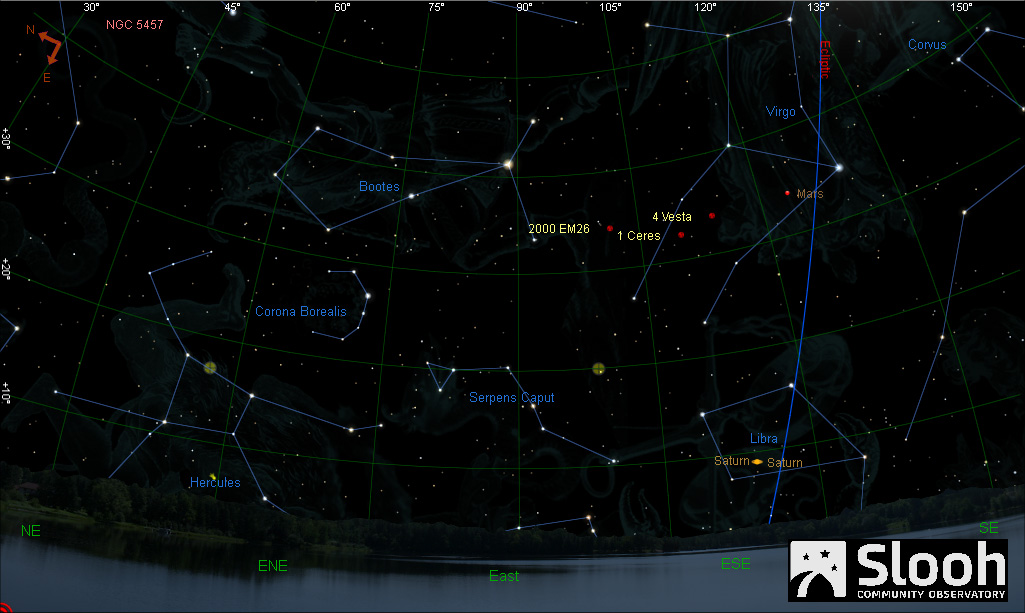Huge Asteroid to Fly Safely By Earth Monday: Watch It Live

An asteroid the size of three football fields is set to make a close brush of Earth on Monday (Feb. 17), and you can watch the flyby in a live webcast.
Near-Earth asteroid 2000 EM26 poses no threat of actually hitting the planet, but the online Slooh Space Camera will track the asteroid as it passes by Earth on Monday. The live Slooh webcast will start at 9 p.m. EST (0200 Feb. 18 GMT), and you can also watch the webcast directly through the Slooh website.
You can also watch the asteroid broadcast live on Space.com. Scientists estimate that 2000 EM26 is about 885 feet (270 meters) in diameter, and it is whizzing through the solar system at a break-neck 27,000 mph (12.37km/s), according to Slooh. During its closest approach, the asteroid will fly about 8.8 lunar distances from Earth. [See photos of potentially dangerous asteroids]
"We continue to discover these potentially hazardous asteroids — sometimes only days before they make their close approaches to Earth," Slooh's technical and research director, Paul Cox said in a statement. "Slooh’s asteroid research campaign is gathering momentum with Slooh members using the Slooh robotic telescopes to monitor this huge population of potentially hazardous space rocks. We need to find them before they find us!"
2000 EM26's flyby comes almost exactly a year after two major near-Earth object (NEO) events on Feb. 15, 2013. That day, as scientists were tracking the extremely close pass of the 98-foot (30 m) asteroid 2012 DA14, another, unrelated space rock unexpectedly exploded above Chelyabinsk, Russia, causing substantial damage to buildings that injured more than 1,000 people with falling glass.
The shockwave caused by the explosion damaged thousands of buildings and left thousands of people injured, but no one was killed. The approximately 65-foot-meteor (20 m) exploded 18 miles (29 km) above the ground, and it released the energy equivalent of about 20 atomic bombs, Slooh officials said.

"On a practical level, a previously-unknown, undiscovered asteroid seems to hit our planet and cause damage or injury once a century or so, as we witnessed on June 20, 1908 and February 15, 2013," Slooh astronomer Bob Berman said in a statement. "Every few centuries, an even more massive asteroid strikes us — fortunately usually impacting in an ocean or wasteland such an Antarctica. But the ongoing threat, and the fact that biosphere-altering events remain a real if small annual possibility, suggests that discovering and tracking all NEOs, as well as setting up contingency plans for deflecting them on short notice should the need arise, would be a wise use of resources."
Get the Space.com Newsletter
Breaking space news, the latest updates on rocket launches, skywatching events and more!
Pieces of the Russian meteorite will be awarded to seven gold medal winners on Saturday at the 2014 Winter Olympics in Sochi, Russia.
The Slooh webcast will include commentary from Mark Boslough, an expert on planetary impacts. You can participate in the broadcast by using the hashtag #asteroid to ask questions during the 2000 EM26 show.
Follow Miriam Kramer @mirikramer and Google+. Follow us @Spacedotcom, Facebook and Google+. Original article on Space.com.
Join our Space Forums to keep talking space on the latest missions, night sky and more! And if you have a news tip, correction or comment, let us know at: community@space.com.

Miriam Kramer joined Space.com as a Staff Writer in December 2012. Since then, she has floated in weightlessness on a zero-gravity flight, felt the pull of 4-Gs in a trainer aircraft and watched rockets soar into space from Florida and Virginia. She also served as Space.com's lead space entertainment reporter, and enjoys all aspects of space news, astronomy and commercial spaceflight. Miriam has also presented space stories during live interviews with Fox News and other TV and radio outlets. She originally hails from Knoxville, Tennessee where she and her family would take trips to dark spots on the outskirts of town to watch meteor showers every year. She loves to travel and one day hopes to see the northern lights in person. Miriam is currently a space reporter with Axios, writing the Axios Space newsletter. You can follow Miriam on Twitter.









